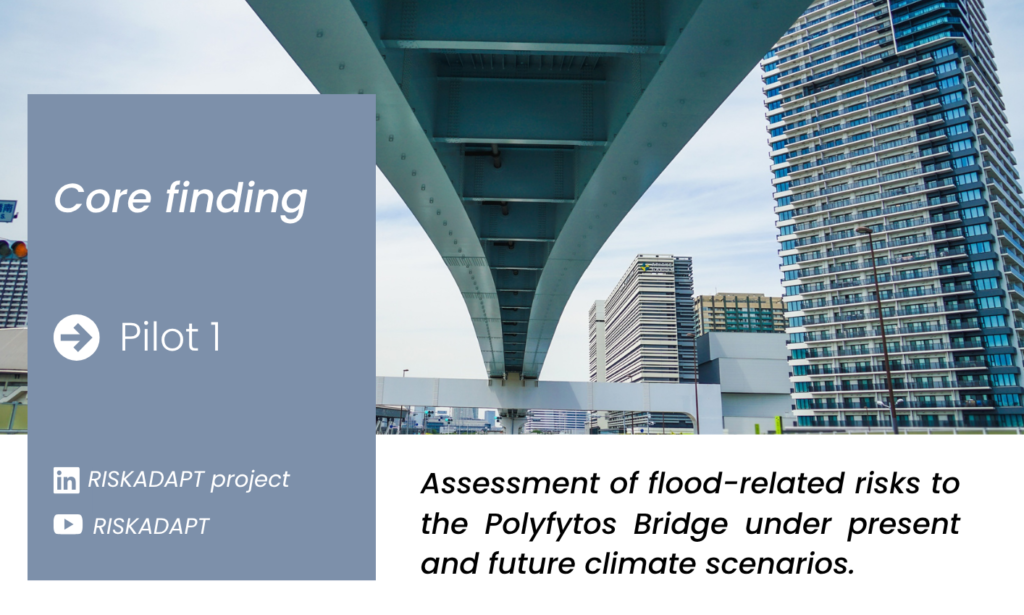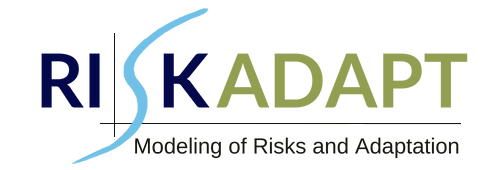
Climate change will impact society and the economy. An example is water availability for agriculture, energy production, and urban and industrial use. Rivers are an essential source of water, as exemplified by the Aliakmon River, the largest river in Greece. The river feeds the Polyfytos Lake and is crucial for the regional economy by delivering water for agriculture, urban water and hydropower generation.
The focus of the hydrological and hydraulic study is the Polyfytos bridge, which spans over the Polyfytos Lake reservoir. The study particularly examines the consequences of extreme rainfall resulting in hydrodynamic loads on the piers and abutments of the bridge, based on present and future change predictions.
This addresses the current gap in site-specific modelling of infrastructure vulnerability to climate-induced extreme events. Existing flood risk assessments rarely combine hydrological and hydraulic modelling under future climate scenarios, especially in data-scarce catchments. The lack of high-resolution input data and limited integration between climate projections, hydrodynamic loads, and structural response hinder the ability to quantify risks and design effective adaptation measures. This study provides a framework and practical methodology to overcome these limitations.
What was done?
A wide range of data was collected, including topography, land use, soil characteristics, and rainfall, to develop hydrological and hydraulic models. These models were used to convert extreme precipitation into extreme discharges, simulate the propagation of flood waves along the river and reservoirs, and assess the resulting hydrodynamic loads and potential impacts on bridge piers and abutments under present and future climate scenarios.
Methods and approaches
The approach involved collecting and processing all necessary input data, including topography, land use, hydrologic soil groups, extreme precipitation, and lake bathymetry. Using these datasets, a hydrological model was developed to transform extreme rainfall into river discharges, and a hydraulic model to simulate flow propagation along the river and reservoir. These models were applied to estimate hydrodynamic loads on the bridge piers and abutments under present and future climate scenarios.
Main results
The hydrological model for present climate conditions showed that extreme rainfall events with return periods of 50, 100, and 1,000 years (72-hour duration) result in maximum inflows to the Polyfytos Lake of approximately 2,400 m³/s, 3,100 m³/s, and 6,350 m³/s, respectively. Future climate scenarios indicated variable impacts on peak discharges, with some projections showing increases and others showing decreases, depending on the model combination.
The hydraulic modelling results revealed that hydrodynamic loads and scour risks on the Polyfytos Bridge piers are low, mainly due to the large water depths, which result in relatively low flow velocities in the main river channel, even during flood events. However, these findings should be interpreted with caution, as detailed bathymetric and sediment composition data were not available for the analysis.
How results adress the need
The hydrological and hydraulic modelling results demonstrate that the piers and abutments of the Polyfytos Bridge are not at significant risk during high-water events. These findings address the identified gap by providing a site-specific, model-based assessment of climate-induced hydrodynamic impacts on bridge infrastructure, supporting evidence-based adaptation planning and risk management under future climate conditions.
Innovation compared to practice
While hydrological and hydraulic modelling are standard methods, the innovation lies in their integrated application to a data-scarce catchment using global datasets and future climate scenarios. This approach enables site-specific assessment of bridge vulnerability to extreme events under changing climate conditions.
Conclusions & Next steps
The modelling results provide a scientific basis for assessing climate-related risks to bridge infrastructure. They support future technical studies and adaptation planning, informing policy decisions and enhancing regional resilience by ensuring the safety and reliability of critical transport links under future climate conditions.
The results of the hydrological and hydraulic modelling can also inform future policies and standards related to the assessment and management of climate change impacts on bridge infrastructure. They provide practical guidance for integrating climate projections into design and maintenance practices, serving as a reference for similar studies in other regions or infrastructure assets.
The study results will support RISKADAPT partners and practitioners by demonstrating the data requirements and modelling approach needed to simulate extreme rainfall, discharges, and hydrodynamic impacts. The next steps include applying the developed methodology to other pilot sites, refining the models with more detailed local data, and using the results to support adaptation strategies for bridge infrastructure under climate change.
